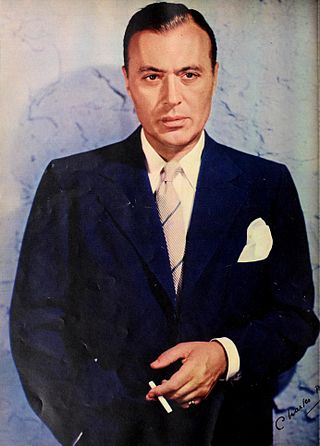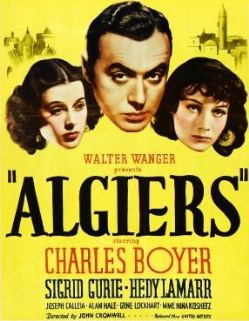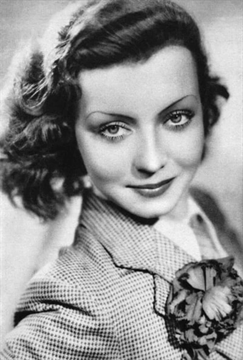Related Research Articles

Charles Boyer was a French-American actor who appeared in more than 80 films between 1920 and 1976. After receiving an education in drama, Boyer started on the stage, but he found his success in American films during the 1930s. His memorable performances were among the era's most highly praised, in romantic dramas such as The Garden of Allah (1936), Algiers (1938), and Love Affair (1939), as well as the mystery-thriller Gaslight (1944). He received four Oscar nominations for Best Actor. He also appeared as himself on the CBS sitcom I Love Lucy.

Fréhel was a French singer and actress.

Edwin Eugene Lockhart was a Canadian-American character actor, playwright, singer and lyricist. He appeared in over 300 films, and received an Academy Award nomination for Best Supporting Actor for his role as Regis in Algiers (1938), the American remake of Pepe le Moko.

Algiers is a 1938 American drama film directed by John Cromwell and starring Charles Boyer, Sigrid Gurie, and Hedy Lamarr. Written by John Howard Lawson, the film is about a notorious French jewel thief hiding in the labyrinthine native quarter of Algiers known as the Casbah. Feeling imprisoned by his self-imposed exile, he is drawn out of hiding by a beautiful French tourist who reminds him of happier times in Paris. The Walter Wanger production was a remake of the successful 1937 French film Pépé le Moko, which derived its plot from the Henri La Barthe novel of the same name.
Poetic realism was a film movement in France of the 1930s. More a tendency than a movement, poetic realism is not strongly unified like Soviet montage or French Impressionism but were individuals who created this lyrical style. Its leading filmmakers were Pierre Chenal, Jean Vigo, Julien Duvivier, Marcel Carné, and, perhaps the movement's most significant director, Jean Renoir. Renoir made a wide variety of films some influenced by the leftist Popular Front group and even a lyrical short feature film. Frequent stars of these films were Jean Gabin, Michel Simon, Simone Signoret, and Michèle Morgan.

Julien Duvivier was a French film director and screenwriter. He was prominent in French cinema in the years 1930–1960. Amongst his most original films, chiefly notable are La Bandera, Pépé le Moko, Little World of Don Camillo, Panic (Panique), Deadlier Than the Male and Marianne de ma jeunesse.

Pépé le Moko is a 1937 French film directed by Julien Duvivier starring Jean Gabin, based on a novel of the same name by Henri La Barthe and with sets by Jacques Krauss. An example of the 1930s French movement known as poetic realism, it recounts the trapping of a gangster on the run in Algiers, who believes that he is safe from arrest in the Casbah.
Gaston Modot was a French actor. For more than 50 years he performed for the cinema working with a number of great French directors.

Gabriel Gabrio was a French stage and film actor whose career began in cinema in the silent film era of the 1920s and spanned more than two decades. Gabrio is possibly best remembered for his roles as Jean Valjean in the 1925 Henri Fescourt-directed adaptation of Victor Hugo's Les Misérables, Cesare Borgia in the 1935 Abel Gance-directed biopic Lucrèce Borgia and as Carlos in the 1937 Julien Duvivier-directed gangster film Pépé le Moko, opposite Jean Gabin.

Saturnin Fabre was a French film actor.
Fernand Charpin was a French actor. He is known for his role as Honoré Panisse in Marcel Pagnol's Marseille trilogy, beginning with Marius in 1931.

Robert Vernay was a French director and screenwriter.

Arthur L. Mayer was an American film producer and film distributor who worked with Joseph Burstyn in distributing films directed by Roberto Rossellini and other famous European film directors. Some films were distributed under the name Burstyn-Mayer Inc. Mayer was also interviewed by Warren Beatty for Beatty's film Reds (1981).

Mireille Césarine Balin was a French-Italian actress.

Gilbert Gil was a French film actor. He also directed a single film Criminal Brigade in 1947.
Jules Kruger (1891–1959) was a French cinematographer. He is known particularly for films which he photographed in the 1920s and 1930s for Abel Gance, Marcel L'Herbier, Raymond Bernard, and Julien Duvivier. He also worked in Great Britain and in Spain.
Marguerite Beaugé was a French film editor. Beaugé died in April 1977. Her daughter, Yvonne Martin, was also a renowned film editor.
Lucas Gridoux was a Romanian-born French stage and film actor.
Jacques Krauss was a French art director. He had a notable influence on the visual look of French poetic realist films before the Second World War, due to his work with Julien Duvivier.

Gisèle Préville (1918–2006) was a French film actress and beauty contestant. She entered the film industry after being crowned Miss Paris in 1934 and Miss France in 1935. While she mainly featured in French films, she also starred in the British films Against the Wind (1948) and The Dancing Years (1950).
References
- ↑ Hayward p.172